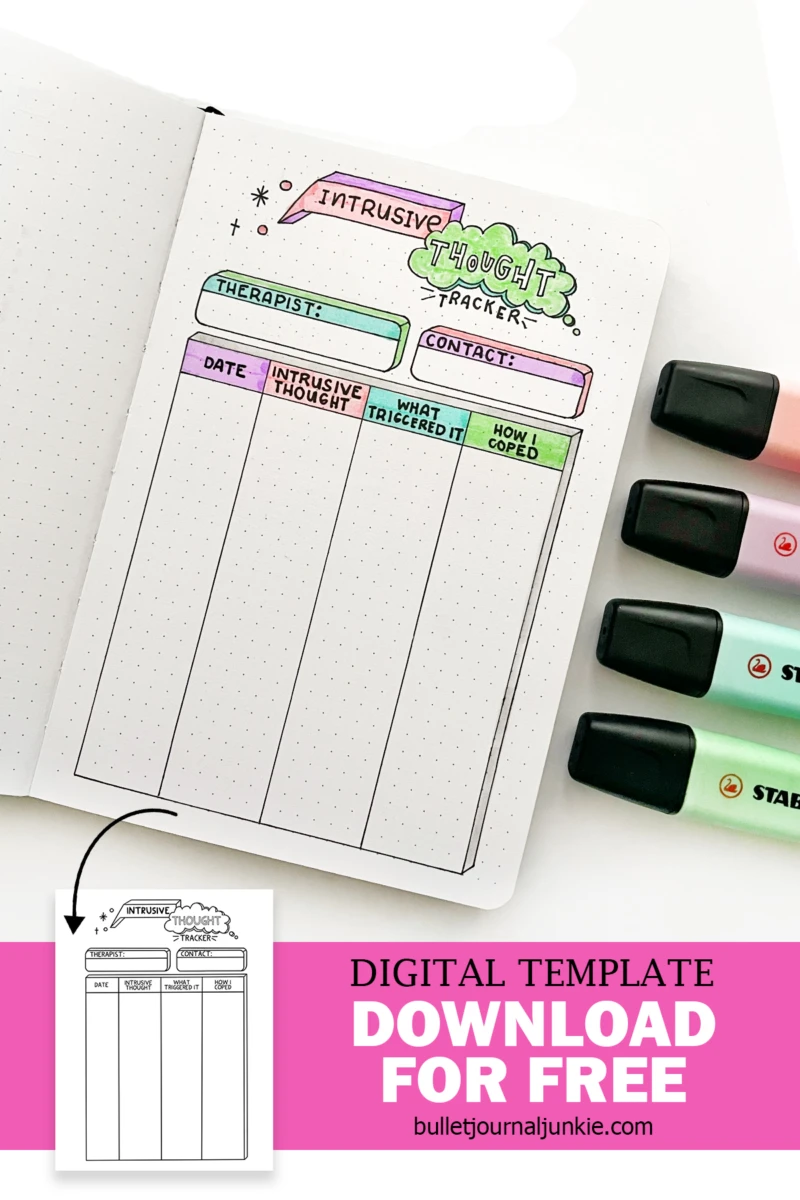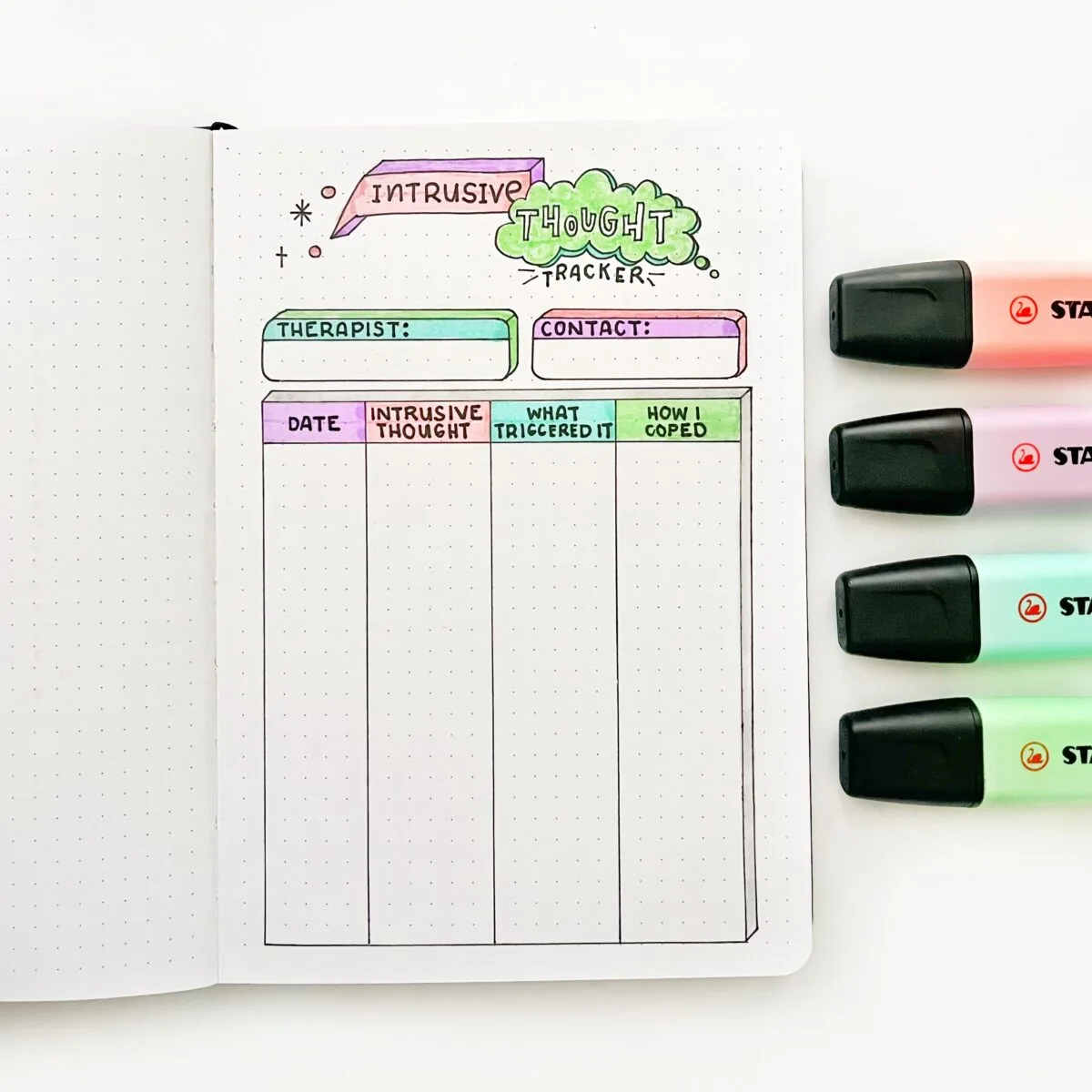After spending long hours at work or school, you’re excited to hit the sack and call it a day. But as soon as you rest your head on your pillow, a sudden unwanted thought creeps in and keeps you wide awake. Does it feel familiar to you? Probably yes, and that’s why today’s blog is about how an intrusive thought tracker layout may help us keep a positive mindset.
In this article, you’ll find:
- A free printable PDF download of an intrusive thought bullet journal layout
- What an intrusive thought tracker is and how it can help in de-cluttering our minds
- Instructions for how to create an intrusive tracker layout in your bujo
- Plus tips on using variations of this layout to match your design theme and logging needs
Some years ago, I used to be overwhelmed by schoolwork and my part-time job schedule. I would toss and turn in bed whenever an unwelcome thought came to me such as missing the bus in the morning. Thankfully, with an intrusive thought tracker, I no longer dwell on unwanted scenarios. Hopefully, this article may help you manage yours so they don’t interfere with your well-being and quality of life.

What Is The Intrusive Thought Tracker Layout?
An intrusive thought tracker is a layout designed to help journalers monitor unwanted thoughts that may interfere with our thinking processes and daily activities. It identifies unwelcome thoughts, what triggered them, and how we were able to cope.
In a way, the intrusive thought tracker layout involves a cause-and-effect analysis by allowing us to describe our triggers and identify our course of action or coping mechanism. It keeps a record of how our minds functioned on specific occasions and documents our solutions.
How The Intrusive Thought Tracker May Help Manage Unwanted Thoughts
An intrusive thought tracker may assist us in problem-solving for similar triggers in the future. By showing us how we coped in the past with unwanted “worst case scenarios” in our heads, we may easily refer to these as sort of a first-aid response when they occur again.
Similarly, having an intrusive thought tracker may shed light on our thought process. This may help us make intentional habits to avoid being overwhelmed or triggered by certain things in the first place.
Research is mixed on how journaling can help improve the symptom of intrusive thoughts. 1 One research study found “Expressive writing did not affect the frequency of intrusive thoughts, but it moderated the impact of intrusive thoughts on depressive symptoms” 2 but the evidence is clear that our brains are better at processing important information when we aren’t distracted by intrusive thoughts 3
While journaling about intrusive thoughts is unlikely to stop them, used in combination with therapy, choosing a brief period of time and recording intrusive thoughts that occur during that time may be an effective way to gather information that fuels self-advocacy, better mental health care, and recovery.
Download This Free Printable Intrusive Thought Tracker Layout
If it’s your first time discovering this tracker layout, making one from scratch may seem daunting since it is different from other bujo trackers you’ve heard of. Hence, I suggest that you use this printable PDF of my intrusive thought tracker layout, so you don’t feel intimidated by the process.
How To Make An Intrusive Thought Tracker In Your Journal
How To Make An Intrusive Thought Tracker In Your Journal
Total time: 15 minutes
Draw an outline of the table, tracker title, and detail boxes
Using a pencil and a ruler, draw a table that covers 90% of the journal page. The topmost space should be allocated to the tracker title that should read as “Intrusive Thought Tracker”. Under this, draw two boxes side by side that are spacious enough to contain a few words for contact details.
You can get as creative as you want when designing the title. I’ve used speech bubbles for mine because I find them suitable for the purpose of the tracker, which is to sort my thoughts.
Trace the outline with a ball-point pen
Make the table pattern permanent by tracing it in ink. Erase the penciled outline afterward to clean the edges.
Decorate your tracker
Prettify your tracker to match your bujo aesthetics. I colored mine using highlighter pens to give it a minimalistic look yet less formal. This way, I would not think of the tracker as too rigid or something serious to feel pressured about.
Jot down your intrusive thoughts
Write every unwelcome thought as it comes to you. Indicate the date and be as accurate as possible when describing your intrusive thoughts along with their triggers. Then right after you specify them, indicate what you did to address the matter.
Supply:
- Notebook
- Pen
- Ruler
- Marker
- Pencil
Variations for Intrusive Thought Tracker Bullet Journal Layout
Some users have come up with creative ways to make their intrusive thought trackers rather appealing and less intimidating to commit to. For instance, there are design layouts that use flowcharts wherein the triggers are written at the top and followed by a sequence of intrusive thoughts, interpretations, and coping mechanisms.
Other variations of this intrusive thought tracker layout use metaphorical illustrations that depict how we may address an unwanted thought. One example is a hollow airplane at takeoff where you can write a trigger. You will follow the dashed lines to the next hollow planes, representing a step-by-step approach to landing on the solution or remedy.
When Intrusive Thought Tracker Layout Might Be Most Helpful
An intrusive thought tracker layout might be most helpful when we are dealing with overwhelming situations where we can’t help but overthink outcomes. Instead of being engrossed and entertaining unwanted thoughts regarding our situations, we may simply jot them down as if dumping them on paper and out of our headspace.
In turn, we will be encouraged to address our triggers once we become aware of our thinking patterns.
How Often To Use Intrusive Thought Tracker In A Journal
We may use the intrusive thought tracker layout whenever we feel overwhelmed by worries and negative thinking. This may be more beneficial every time our minds would replay a series of experiences or when we imagine worst-case scenarios that often keep us up at night.
Putting such thoughts on paper may bring us clarity and a good night’s sleep. It may sound counterintuitive, but it may be best not to suppress unwanted thoughts as they come to us. Research has revealed that the more we try not to think about something, the more it seems to occupy our minds. 4 Hence, writing our thoughts, no matter how challenging, may help us manage them.
Final Thoughts On Using Intrusive Thought Tracker in 2022
The intrusive thought tracker layout still works great for bullet journals in 2022, especially given the renewed interest among young people like us to pursue self-care habits. In this article, you have learned how to use an intrusive thought tracker and how it may help with stress management, as well as creating design variations to match your aesthetic preferences.
Image Description For Screen Readers
The image shows a journal notebook opened at a page entitled “Intrusive Thought Tracker”. The word “Intrusive” is framed inside a rectangular speech bubble and is colored in pink and purple. Under this is the word “Thought” framed inside a cloud speech bubble and colored in green.
On the lower right corner of the image, a hand holding a ballpoint pen can be seen finishing a sentence under the “Intrusive Thought” column of the tracker.
Under the title enclosed in speech bubbles, there are two rectangular boxes. The one on the left shows the therapist’s name as Dr. Williams. The box next to it on the right contains their contact number.
Under the therapist’s name and contact number, a table is drawn with four columns. The titles of the columns from left to right are as follows: “Date”, “Intrusive Thought”, “What Triggered It”, and “How I Coped”.
For Date 3, the “Intrusive Thought” is written as “I’m going to have a serious illness”. In the next column, “headache” indicates “What Triggered It”. The “How I Coped” column indicates “Took a nap”.
For Date 11, the “Intrusive Thought” is written as “I didn’t turn off the clothes iron. Our house will burn down”. In the next column, “browsing of clothes online” indicates “What Triggered It”. The “How I Coped” column indicates “Called at home ASAP to check if the clothes iron is turned off.”
For Date 20, the “Intrusive Thought” is written as “I can’t finish the report before the deadline.” This is where the tip of the pen is shown being held by the hand.
Sources
- Lepore, S. J., Greenberg, M. A., Bruno, M., & Smyth, J. M. (2002). Expressive writing and health: Self-regulation of emotion-related experience, physiology, and behavior. [↩]
- Lepore, S. J. (1997). Expressive writing moderates the relation between intrusive thoughts and depressive symptoms. Journal of personality and social psychology, 73(5), 1030. [↩]
- Brewin, C. R., & Smart, L. (2005). Working memory capacity and suppression of intrusive thoughts. Journal of behavior therapy and experimental psychiatry, 36(1), 61-68. [↩]
- Wegner, D. 1987. Paradoxical Effects of Thought Suppression[↩]

